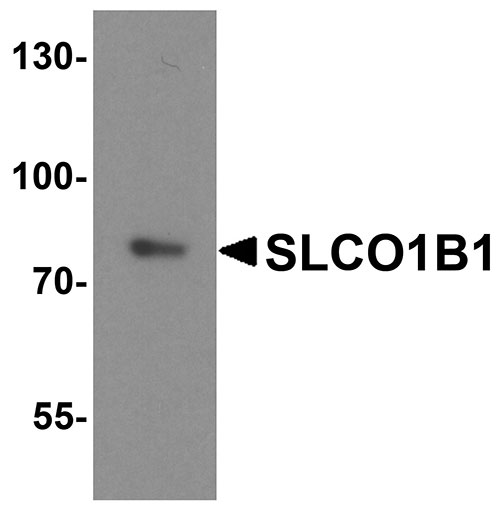SLCO1B1 Antibody
- 产品详情
- 实验流程
- 背景知识
Application
| WB, IF, E |
|---|---|
| Primary Accession | Q9Y6L6 |
| Other Accession | NP_006437, 225543525 |
| Reactivity | Human |
| Host | Rabbit |
| Clonality | Polyclonal |
| Isotype | IgG |
| Calculated MW | 76449 Da |
| Concentration (mg/ml) | 1 mg/mL |
| Conjugate | Unconjugated |
| Application Notes | SLCO1B1 antibody can be used for detection of SLCO1B1 by Western blot at 1 - 2 µg/ml. For immunofluorescence start at 20 µg/mL. |
| Gene ID | 10599 |
|---|---|
| Other Names | Solute carrier organic anion transporter family member 1B1, Liver-specific organic anion transporter 1, LST-1, OATP-C, Sodium-independent organic anion-transporting polypeptide 2, OATP-2, Solute carrier family 21 member 6, SLCO1B1, LST1, OATP1B1, OATP2, OATPC, SLC21A6 |
| Target/Specificity | SLCO1B1; SLCO1B1 antibody is human specific. At least four isoforms of SLCO1B1 are known to exist. This antibody is predicted to not cross-react with other SLCO1B proteins. |
| Reconstitution & Storage | SLCO1B1 antibody can be stored at 4℃ for three months and -20℃, stable for up to one year. |
| Precautions | SLCO1B1 Antibody is for research use only and not for use in diagnostic or therapeutic procedures. |
| Name | SLCO1B1 |
|---|---|
| Synonyms | LST1, OATP1B1, OATP2, OATPC, SLC21A6 |
| Function | Mediates the Na(+)-independent uptake of organic anions (PubMed:10358072, PubMed:15159445, PubMed:17412826). Shows broad substrate specificity, can transport both organic anions such as bile acid taurocholate (cholyltaurine) and conjugated steroids (dehydroepiandrosterone 3-sulfate, 17-beta-glucuronosyl estradiol, and estrone 3-sulfate), as well as eicosanoids (prostaglandin E2, thromboxane B2, leukotriene C4, and leukotriene E4), and thyroid hormones (T4/L-thyroxine, and T3/3,3',5'-triiodo-L-thyronine) (PubMed:10358072, PubMed:10601278, PubMed:10873595, PubMed:11159893, PubMed:12196548, PubMed:12568656, PubMed:15159445, PubMed:15970799, PubMed:16627748, PubMed:17412826, PubMed:19129463, PubMed:26979622). Can take up bilirubin glucuronides from plasma into the liver, contributing to the detoxification-enhancing liver-blood shuttling loop (PubMed:22232210). Involved in the clearance of endogenous and exogenous substrates from the liver (PubMed:10358072, PubMed:10601278). Transports coproporphyrin I and III, by-products of heme synthesis, and may be involved in their hepatic disposition (PubMed:26383540). May contribute to regulate the transport of organic compounds in testes across the blood-testis-barrier (Probable). Can transport HMG-CoA reductase inhibitors (also known as statins), such as pravastatin and pitavastatin, a clinically important class of hypolipidemic drugs (PubMed:10601278, PubMed:15159445, PubMed:15970799). May play an important role in plasma and tissue distribution of the structurally diverse chemotherapeutic drug methotrexate (PubMed:23243220). May also transport antihypertension agents, such as the angiotensin-converting enzyme (ACE) inhibitor prodrug enalapril, and the highly selective angiotensin II AT1-receptor antagonist valsartan, in the liver (PubMed:16624871, PubMed:16627748). Shows a pH-sensitive substrate specificity towards prostaglandin E2 and T4 which may be ascribed to the protonation state of the binding site and leads to a stimulation of substrate transport in an acidic microenvironment (PubMed:19129463). Hydrogencarbonate/HCO3(-) acts as the probable counteranion that exchanges for organic anions (PubMed:19129463). |
| Cellular Location | Basolateral cell membrane; Multi-pass membrane protein. Basal cell membrane; Multi-pass membrane protein. Note=Detected in basolateral membranes of hepatocytes (PubMed:12196548). Localized to the basal membrane of Sertoli cells (PubMed:35307651). |
| Tissue Location | Highly expressed in liver, at the basolateral membranes of centrilobular hepatocytes (PubMed:10358072, PubMed:10601278, PubMed:10873595, PubMed:12196548, PubMed:22232210) Expressed in liver (at protein level) (PubMed:15159445). Expressed in fetal liver (PubMed:10873595). Not detected in heart, brain, placenta, lung, skeletal muscle, kidney, pancreas, spleen, thymus, prostate, testis, ovary, small intestine, colon and leukocyte (PubMed:10358072, PubMed:10873595). In testis, primarily localized to the basal membrane of Sertoli cells and weakly expressed in Leydig cells and within the tubules (PubMed:35307651). |
For Research Use Only. Not For Use In Diagnostic Procedures.
Provided below are standard protocols that you may find useful for product applications.
BACKGROUND
SLCO1B1 is a transmembrane receptor that mediates the sodium-independent uptake of numerous endogenous compounds including bilirubin, 17-beta-glucuronosyl estradiol and may play an important role in the clearance of bile acids and organic anions from the liver (1,2). It contains one Kazal-like domain and belongs to the organo-anion transporter family (2,3). SLCO1B1 is highly expressed in liver and is localized to the basolateral hepatocyte membrane. It is responsible for the hepatic uptake of the liver-specific hydroxymethylglutaryl-CoA reductase inhibitor in mouse, rat and human (3,4).
REFERENCES
Abe T, Kakyo M, Tokui T, et al. Identification of a novel gene family encoding human liver-specific organic anion transporter LST-1. J. Biol. Chem. 1999; 274:17159-63.
Konig J, Cui Y, Nies AT, et al. A novel human organic anion transporting polypeptide localized to the basolateral hepatocyte membrane. Am. J. Physiol. Gastrointest. Liver Physiol. 2000; 278:G156-64.
Michalski C, Cui Y, Nies AT, et al. A naturally occurring mutation in the SLC21A6 gene causing impaired membrane localization of the hepatocyte uptake transporter. J. Biol. Chem. 2002; 277:43058-63.
Yao J, Hong W, Huang J, et al. N-Glycosylation dictates proper processing of organic anion transporting polypeptide 1B1. PLoS One 2012; 7:e52563.
终于等到您。ABCEPTA(百远生物)抗体产品。
点击下方“我要评价 ”按钮提交您的反馈信息,您的反馈和评价是我们最宝贵的财富之一,
我们将在1-3个工作日内处理您的反馈信息。
如有疑问,联系:0512-88856768 tech-china@abcepta.com.























 癌症的基本特征包括细胞增殖、血管生成、迁移、凋亡逃避机制和细胞永生等。找到癌症发生过程中这些通路的关键标记物和对应的抗体用于检测至关重要。
癌症的基本特征包括细胞增殖、血管生成、迁移、凋亡逃避机制和细胞永生等。找到癌症发生过程中这些通路的关键标记物和对应的抗体用于检测至关重要。 为您推荐一个泛素化位点预测神器——泛素化分析工具,可以为您的蛋白的泛素化位点作出预测和评分。
为您推荐一个泛素化位点预测神器——泛素化分析工具,可以为您的蛋白的泛素化位点作出预测和评分。 细胞自噬受体图形绘图工具为你的蛋白的细胞受体结合位点作出预测和评分,识别结合到自噬通路中的蛋白是非常重要的,便于让我们理解自噬在正常生理、病理过程中的作用,如发育、细胞分化、神经退化性疾病、压力条件下、感染和癌症。
细胞自噬受体图形绘图工具为你的蛋白的细胞受体结合位点作出预测和评分,识别结合到自噬通路中的蛋白是非常重要的,便于让我们理解自噬在正常生理、病理过程中的作用,如发育、细胞分化、神经退化性疾病、压力条件下、感染和癌症。







